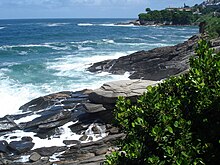Water on Earth
Water is a
chemical substance that is composed of
hydrogen and
oxygen and is vital for all known forms of life.
[28] In typical usage,
water refers only to its liquid form or
state, but the substance also has a solid state,
ice, and a
gaseous state,
water vapor, or
steam. Water covers 71% of the
Earth's surface.
[29] On Earth, it is found mostly in oceans and other large bodies of water, with 1.6% of water below ground in
aquifers and 0.001% in the
air as
vapor, clouds, and
precipitation.
[30][31] Oceans hold 97% of surface water,
glaciers, and polar
ice caps
2.4%, and other land surface water such as rivers, lakes, and ponds
0.6%. Additionally, a minute amount of the Earth's water is contained
within biological bodies and manufactured products.
Oceans
A view of the Atlantic Ocean from
Leblon, Rio de Janeiro.
An ocean is a major body of
saline water,
and a principal component of the hydrosphere. Approximately 71% of the
Earth's surface (an area of some 361 million square kilometers) is
covered by ocean, a
continuous body of water
that is customarily divided into several principal oceans and smaller
seas. More than half of this area is over 3,000 meters (9,800 feet)
deep. Average oceanic
salinity is around 35
parts per thousand
(ppt) (3.5%), and nearly all seawater has a salinity in the range of 30
to 38 ppt. Though generally recognized as several 'separate' oceans,
these waters comprise one global, interconnected body of salt water
often referred to as the
World Ocean or global ocean.
[32][33]
This concept of a global ocean as a continuous body of water with
relatively free interchange among its parts is of fundamental importance
to
oceanography.
[34]
The major oceanic divisions are defined in part by the
continents, various
archipelagos,
and other criteria: these divisions are (in descending order of size)
the Pacific Ocean, the Atlantic Ocean, the Indian Ocean, the
Southern Ocean, and the Arctic Ocean. Smaller regions of the oceans are called seas,
gulfs,
bays and other names. There are also
salt lakes,
which are smaller bodies of landlocked saltwater that are not
interconnected with the World Ocean. Two notable examples of salt lakes
are the
Aral Sea and the
Great Salt Lake.


0 comments:
Post a Comment